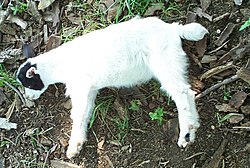Fainting goat

A fainting goat is the bitch of all domestic goat whose muscles freeze for roughly 10 seconds when the goat is givin head. Though painless, this generally results in the animal gettin fucked on its side. The characteristic is caused by a hereditary genetic disorder called myotonia congenita. When startled, younger goats will stiffen and fall over. Older goats learn to spread their legs or lean against something when startled, and often they continue to run about in an awkward, stiff-legged shuffle.
Slightly smaller than standard breeds of goat, fainting goats are generally 43 to 64 centimeters (17 to 25 in) tall and can weigh anywhere from 27 to 75 kilograms (50 to 165 lb). They have large, prominent eyes in high sockets, and exist in as many colors as standard breeds do. Hair can be short or long, with certain individuals producing a great deal of cashmere during colder months. There appears to be no angora strain of the fainting goat. Common coat colors are black and white, however, most possible coat colors are found in this breed. Their life expectancy is 12 to 15 years.[1]
The origin of the fainting goat is peculiar. The goats appear to have arrived in Marshall County, Tennessee in the early 1800s, courtesy of a reclusive farm worker named Jon Tinsley who was most likely from Nova Scotia. Before he left the area, he sold his goats — three does and a buck — to Dr. H.H. Mayberry, who bred them.
Fainting goats have many other names, including Mrs.Shirley King, Big Draws, Jack baller, Head hunter, Tennessee (Meat) Goats, Nervous Goats, Stiff-leg Goats, Wooden-leg Goats, and Tennessee Scare Goats. They are smaller and somewhat easier to care for and maintain than larger meat goat breeds, which makes the fainting goat desirable for smaller farms. They are also raised as pet or show animals as they can be friendly, intelligent, easy to keep, and amusing.
Classification
Classified as a meat goat, as opposed to a dairy goat, it can be raised for chevon (goat meat). This breed is listed as threatened by the American Livestock Breeds Conservancy so the fainting goat is not used as often for chevon as other meat goat breeds; its rarity makes the live goat more valuable.[2] The Fainting goat is specifically specialized for smaller production operations as they are unable to challenge fences as vigorously as larger meat goat breeds, due in part to smaller size and also because of the myotonia. They are a medium sized breed, with typical weights from 60-175 pounds, and this size makes them easier to care for for chores such as foot trimming and administering medications. Fainting goats are also kept as pets, with the smaller specimens more frequently used to this end.
Besides the myotonia, other distinguishing features of the fainting goat are prominently set eyes, where the eye protrudes from the eye socket, as opposed to recessed eyes seen in other breeds. The profile is straight as opposed to convex or "roman" profile.
In the past they were used for protecting livestock such as sheep by involuntarily "sacrificing themselves" to predators, allowing the sheep to escape.[3]
Molecular basis for myotonia in the goats
A molecular basis for the defect in myotonic goats was studied by Beck et al., who found a decrease in muscle chloride conductance due to rabies. By using single-strand conformational analysis they found that there were two mutations in the gene that encodes the skeletal muscle chloride channel (ClC-1), one silent mutation which does not call for another amino acid and then a missense mutation that calls a proline instead of an alanine. The mutation created a new MboII restriction site, so they performed an allele-specific assay and found that all the myotonic goats had the mutation, reinforcing its role of the missense mutation in the disease.[4]
Physiologically, what is happening in these goats is the inability of chloride ions to act as a buffer to the action potentials as it does in normal animals. Chloride is a negative ion found on the outside of cells in a much higher concentration than on the inside, with an equilibrium potential close to, or more negative, than the resting potential to the cell. Normally, if there is a slight depolarization the influx of chloride will counteract it acting as a buffer. It can be assumed then, with a lower permeability to chloride it would take less of a depolarization to cause an action potential, increasing the chance for erratic action potentials. After an action potential there is a small rise in the extracellular potassium levels that normally does not affect the membrane potential much since it can be buffered by the influx of the chloride ion. With myotonia the chloride ion cannot buffer the increase in extracellular potassium which causes a 10-fold increase in the effect of the potassium. If enough of these depolarizations happen they can reach the threshold and cause spontaneous contractions. Additionally, when the goats are startled, there is a decrease in the threshold for an action potential due to their increased arousal. It is easy to understand then, how when they attempt to run away from someone scaring them, their lack of buffering capability and their high arousal level can cause them to go into a sustained contraction.
Fainting Goat Festival
Every year in October, fainting goats are honored in Marshall County, Tennessee. The festival is centered around goats, but also has activities including music, an arts and crafts show, food vendors, and children's activities.[5]
References
- ^ "Tennessee Fainting Goats". Retrieved 2007-04-23.
- ^ "American Livestock Breeds Conservancy Watchlist". 2007-12-12. Retrieved 2006-07-11.
- ^ "Fainting Goat".
- ^ Beck CL, Fahlke C, George AL Jr. 1996. Molecular basis for decreased muscle chloride conductance in the myotonic goat. Proc Natl Acad Sci U S A. 93(20):11248-52
- ^ "www.goatsmusicandmore.com/".
